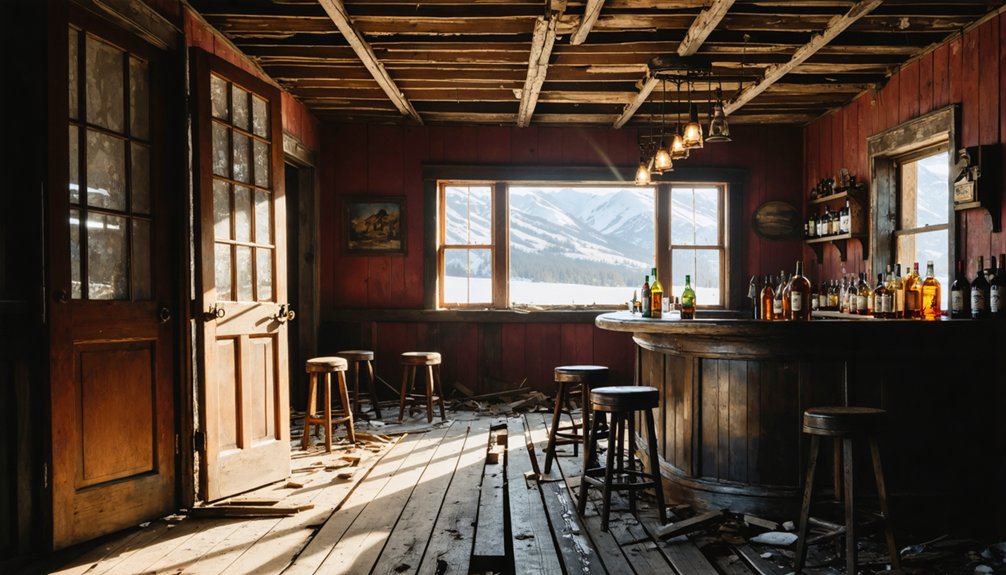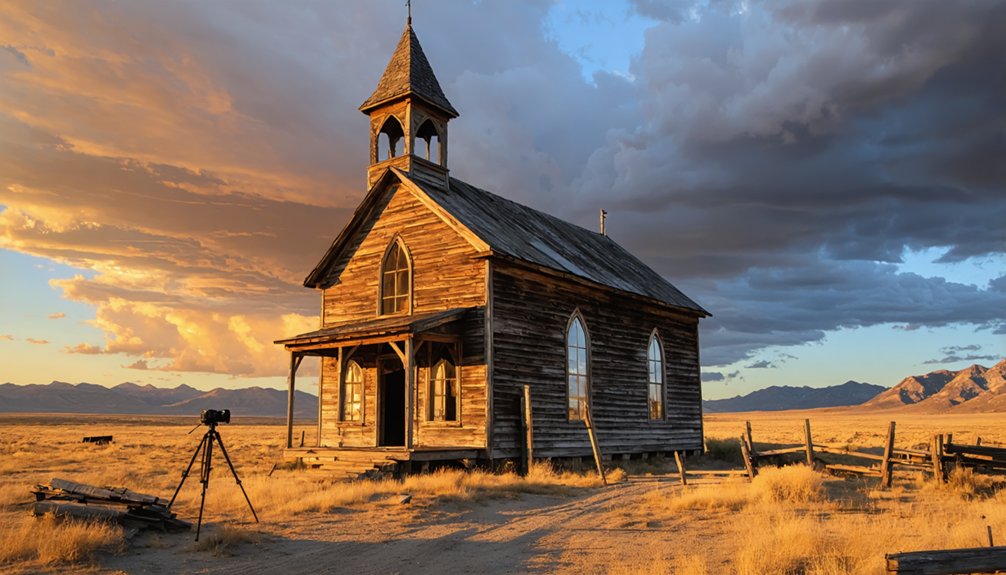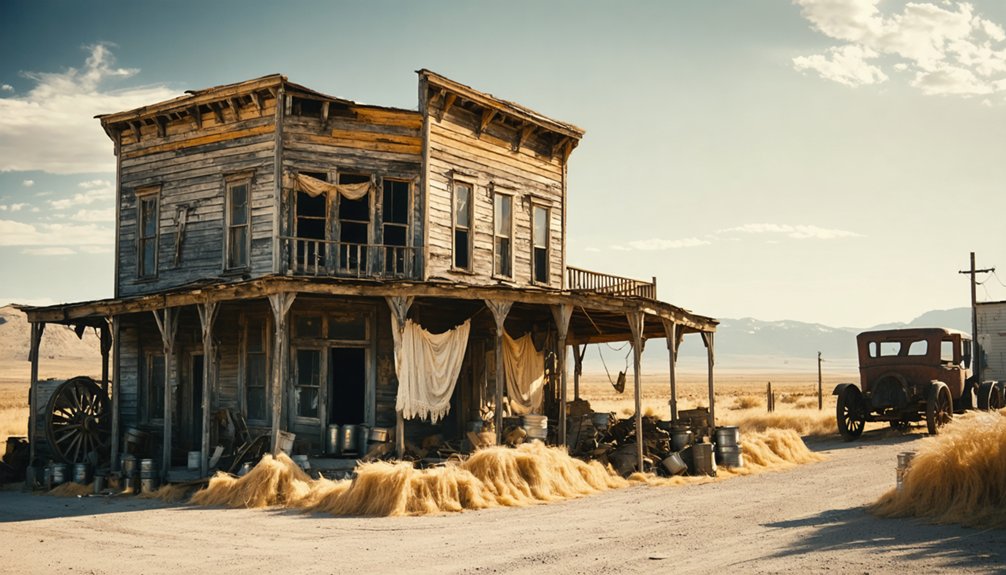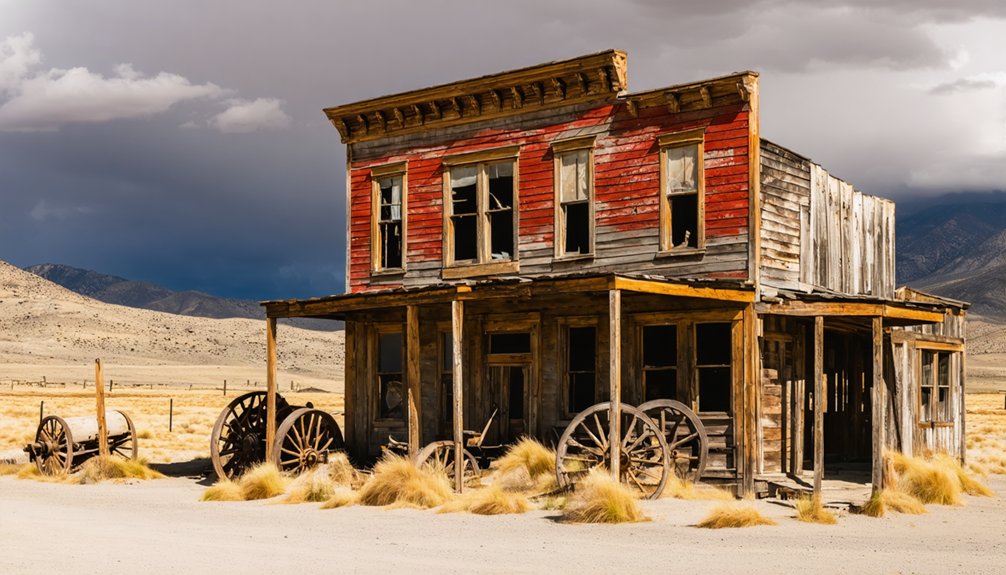Yes, the US has 3,800-4,500 documented ghost towns, with potentially up to 20,000 including undocumented sites. You’ll find the highest concentrations in Texas (511), California (346), and Kansas (308). Most emerged during 1880-1940 following economic booms in mining, railroads, or agriculture, then collapsed when these industries declined. From well-preserved Bodie, California to completely vanished settlements, these abandoned places tell powerful stories about America’s past.
Key Takeaways
- The US has approximately 3,800-4,500 documented ghost towns, potentially reaching 20,000 when including undocumented sites.
- Texas leads the nation with 511 abandoned settlements, followed by California (346) and Kansas (308).
- Most American ghost towns emerged between 1880-1940 during periods of westward expansion and resource-based economic booms.
- Ghost towns are identified by abandoned structures, sharp demographic decline, and vacancy rates exceeding 25%.
- Bodie, California is considered America’s best-preserved Western ghost town, with over 100 standing structures attracting 200,000 visitors annually.
The Rise and Fall of American Ghost Towns
While exploring the American landscape, you’ll discover that most ghost towns emerged during the period of 1880-1940, coinciding with westward expansion and industrialization.
These settlements followed predictable economic cycles—rapid growth during resource booms followed by devastating busts when minerals depleted or commodity prices collapsed.
Mining discoveries, particularly gold, silver, and copper, sparked community development that vanished once resources ran dry. Many abandoned mining towns like Bodie, California still have over 100 structures standing today as testament to their former prosperity.
Transportation changes, like railroad reroutes or highway construction, often sealed a town’s fate by isolating it from commerce.
The social dynamics in these communities reflected their transient nature, with populations flowing in and out based on opportunity.
Natural disasters accelerated abandonment—fires destroyed crucial infrastructure while floods and drought made agricultural towns unsustainable, particularly during the 1930s Dust Bowl crisis that decimated Great Plains communities.
With estimates suggesting between 10,000 to 20,000 ghost towns across America, these abandoned settlements remain scattered throughout the country as physical reminders of boom-and-bust cycles.
Top States With The Highest Concentration of Ghost Towns
You’ll find America’s ghost towns concentrated most heavily in Texas, which leads the nation with 511 abandoned settlements, while California and Kansas follow with 346 and 308 respectively.
The Western Ghost Town Belt encompasses numerous mining-related abandonments across Nevada, Montana, and Colorado, each containing over 100 ghost towns tied to resource extraction booms.
While the Midwest features agricultural abandonments throughout Kansas and South Dakota, the Eastern seaboard contains notably fewer ghost towns, with states like Rhode Island and Connecticut having single-digit counts. Kern County in California stands as the county with the highest concentration of ghost towns, boasting 113 abandoned settlements. According to Professor Peter Ling, these abandoned settlements serve as vivid reminders of America’s turbulent past, often evoking Hollywood images of outlaws and miners.
Western Ghost Town Belt
Across the vast American West, a distinct geographical pattern known as the “Western Ghost Town Belt” encompasses the nation’s highest concentration of abandoned settlements. This region saw its peak ghost town origins during 1880-1940, driven by westward expansion and industrialization.
Texas leads with approximately 550 ghost towns, while California, Nevada, and Colorado follow with significant numbers of mining boomtowns tied to gold and silver rushes.
The belt formed primarily due to resource-based economic cycles. Towns emerged rapidly during mineral discoveries—gold in California, silver in Nevada, or oil in Texas after the 1901 Spindletop discovery—only to be abandoned when resources depleted. Organizations like WikiProject Ghost Towns document and preserve information about these historic settlements for future generations. Oklahoma joins the list with over 240 towns abandoned throughout its history.
With an estimated 3,800-4,500 documented ghost towns (possibly up to 20,000 including undocumented settlements), the Western Ghost Town Belt represents America’s boom-and-bust frontier heritage.
Midwestern Settlement Abandonment
Though the Western states typically dominate ghost town discussions, the American Midwest harbors an unexpectedly high concentration of abandoned settlements. Kansas leads this region with 308 ghost towns, while Oklahoma and South Dakota each host over 235 documented abandoned communities.
Wisconsin’s 155 ghost towns reflect the collapse of mining and logging economies, while Michigan’s 128 abandoned settlements showcase both rural exodus and urban decay. Detroit exemplifies this modern abandonment, with nearly 30% of vacant homes sitting empty for years across multiple ZIP codes.
Minnesota’s 50+ ghost towns and Illinois’ 82 abandoned settlements further illustrate the region’s widespread community collapse. St. Louis, with its 6% retail vacancy rate and severe population decline of 6.6% between 2020-2023, represents another Midwestern city facing ghost town conditions.
This Midwestern abandonment pattern stems from resource depletion, economic diversification failure, and population decline—creating a landscape where the remnants of once-thriving communities now stand in silent testimony to changing fortunes. The United States contains a total of 4,531 ghost towns across all fifty states, with many becoming tourist attractions that preserve their historical significance.
Eastern Forgotten Communities
While the Midwest reveals surprising concentrations of ghost towns, the national distribution of abandoned settlements tells an even more compelling story. Texas dominates with 550 documented ghost towns, while Oklahoma, Kansas, California, Florida, and South Dakota each harbor more than 240 abandoned communities of historical significance.
Unlike their Western counterparts, Eastern forgotten communities primarily manifest as vegetation-covered cellar holes rather than standing structures—victims of time, weather, and human activity. Exploration of these sites offers an adventurous way to engage with American history firsthand. These sites of urban decay are classified from barren ghost towns to semi-abandoned communities, creating a spectrum of abandonment.
Research resources include local historical societies, library archives, and old newspapers, though Eastern ghost towns have been historically overshadowed by Western narratives.
Despite the fact that every U.S. state contains at least one of the 4,531 documented ghost towns.
What Defines a Ghost Town in Modern America
You’ll recognize modern ghost towns by their abandoned but still-standing structures that provide tangible evidence of previous habitation and commerce.
Population metrics offer clear indicators, with sharp demographic decline, high vacancy rates above 25%, and the exodus of young adults serving as warning signs.
These abandoned settlements represent the aftermath of economic shifts, environmental disasters, or infrastructure changes that have fundamentally altered the viability of once-thriving communities. As T. Lindsey Baker observed, ghost towns emerge when the reason for being no longer exists, leaving behind only the physical remnants of what once was.
Abandoned Yet Standing
Despite popular imagery of tumbleweeds rolling through empty streets, defining a ghost town in modern America requires nuanced classification beyond complete abandonment.
You’ll find ghost towns exist along a spectrum of physical conditions and occupancy statuses, from barren sites (the most common with 211 documented examples) to those with historical significance and preserved architecture.
These abandoned settlements can be categorized by their remaining structures: neglected towns with deteriorating buildings (119 examples), historic locations retaining period architecture (57 examples), submerged communities (46 examples), or places with no visible remains (37 examples).
For urban exploration enthusiasts, semi-abandoned and residual population sites offer compelling destinations where you can witness the physical manifestation of economic decline, with rental vacancy rates exceeding 8% and retail vacancies 34% above average signaling communities approaching ghost town status.
Population Decline Markers
Modern ghost towns emerge through identifiable patterns of demographic change that extend beyond physical deterioration.
You’ll recognize these places by their significant population declines—cities like San Francisco (-7.4%) and New York (-6.2%) have experienced alarming drops between 2020-2023. This sustained decrease over multiple years serves as the primary indicator of emerging ghost towns.
Census data reveals that outmigration, particularly among younger residents aged 16-26, compounds population trends and accelerates urban decay.
When analyzing at-risk communities, researchers track these demographic shifts alongside vacancy rates in both residential and commercial properties. A city’s trajectory toward ghost town status becomes evident when examining these metrics collectively, especially when paired with long-term vacancy data showing properties remaining empty for two years or longer.
Must-Visit Ghost Towns for History Enthusiasts

For history enthusiasts seeking to explore America’s forgotten past, ghost towns offer unparalleled windows into bygone eras that have shaped the nation’s development. With over 3,800 mapped ghost towns across America, you’ll find remarkable preservation efforts maintaining their historical integrity.
Bodie attractions showcase America’s best-preserved Western ghost town, where you can wander dusty streets and peer through windows of structures maintained in “arrested decay.” Approximately 200,000 visitors annually experience this authentic gold mining heritage.
Meanwhile, Jerome’s transformation from copper mining hub to thriving cultural destination demonstrates how ghost towns can evolve while preserving their history.
International examples like Craco, Italy demonstrate alternative revival approaches through film production. Whether you’re drawn to pristine preservation or cultural reinvention, these historical sites connect you directly to America’s frontier spirit and industrial past.
Modern Cities at Risk of Becoming Ghost Towns
While America’s historical ghost towns preserve memories of the past, a disturbing trend suggests many thriving modern cities face similar fates in the coming decades.
Nearly 30,000 U.S. cities could see population declines of 12-23% by 2100, with Northeastern and Midwestern cities like Cleveland, Buffalo, and Pittsburgh most vulnerable.
Urban decline threatens thousands of American cities, with the Northeast and Midwest facing the most severe population losses by century’s end.
This urban decay stems from multiple factors: post-industrial decline in manufacturing hubs, climate disasters forcing evacuations, and housing crises triggering population migration.
The effects cascade—as residents leave, tax bases shrink, infrastructure fails, and basic services disappear.
Even once-booming Sunbelt cities now face suburban abandonment patterns similar to Rustbelt declines.
Most concerning is that this trend extends beyond rural areas to mid-sized cities facing economic downturns and climate vulnerabilities.
How Historians Document and Preserve Ghost Town Heritage

Historians face significant challenges when documenting and preserving America’s ghost town heritage, requiring innovative approaches across multiple disciplines. Archival challenges include scattered records and inconsistent census data, forcing researchers to piece together histories through church records, property documents, and genealogical information.
GIS technology revolutionizes this work by overlaying historical maps with current satellite imagery to reveal abandoned infrastructure and settlement patterns. This georeferencing aligns old land surveys with modern coordinates, helping explain why communities disappeared.
Archaeological excavations complement these efforts, uncovering material culture that historical records miss. The National Park Service establishes documentation standards that bring together historians, archaeologists, and GIS specialists. Their collaborative work guarantees these forgotten places aren’t lost to time, while digital platforms coordinate public contributions to document America’s vanishing communities ethically and accurately.
Frequently Asked Questions
Can You Legally Live in an Abandoned Ghost Town?
Walking through legal minefields, you can’t simply occupy abandoned ghost towns. Legal residence requires clear property rights, compliance with zoning laws, infrastructure rehabilitation, and managing ghost town legality constraints—challenging but possible with proper authorization.
How Do Ghost Towns Impact Local Ecosystems After Abandonment?
Ghost towns initially harm ecosystems through pollution and degradation, but you’ll observe gradual ecosystem recovery as wildlife adaptation occurs, with animals colonizing abandoned structures and vegetation reclaiming disturbed areas over time.
Are There Underwater Ghost Towns Beneath America’s Lakes?
Yes, America’s lakes conceal numerous ghost towns deliberately flooded during dam construction. You’ll find these submerged histories throughout the country, offering fascinating underwater archaeology opportunities when water levels recede.
Do Ghost Towns Have Any Special Legal or Tax Status?
Ghost towns don’t receive special legal status simply for abandonment. You’ll find they’re subject to standard property tax regulations, though historic designations may offer preservation incentives and tax benefits to owners.
What Role Did Railroad Abandonment Play in Creating Ghost Towns?
Like a lifeline severed, railroad abandonment left towns to wither. When railroads withdrew service, you’d see complete economic collapse. Town development reversed as railroad history shows—communities that lost their transportation arteries quickly became ghost towns.
References
- https://www.loveexploring.com/gallerylist/188219/the-us-state-with-the-most-ghost-towns-revealed
- https://en.wikipedia.org/wiki/Wikipedia:WikiProject_Ghost_towns
- https://themortgagepoint.com/2024/10/25/americas-new-ghost-towns/
- https://freepages.rootsweb.com/~gtusa/history/
- https://247wallst.com/special-report/2021/05/19/30-american-ghost-towns-7/
- https://en.wikipedia.org/wiki/Ghost_town
- https://www.geotab.com/ghost-towns/
- https://www.wikiwand.com/en/articles/ghost_town
- https://en.wikipedia.org/wiki/Lists_of_ghost_towns_in_the_United_States
- https://www.slideshare.net/slideshow/famous-ghost-towns/26047073



